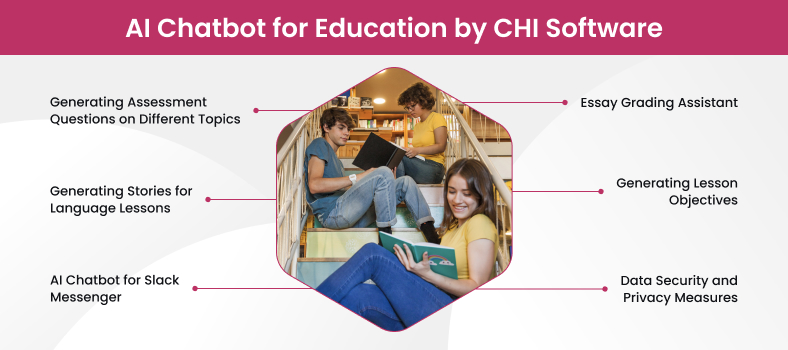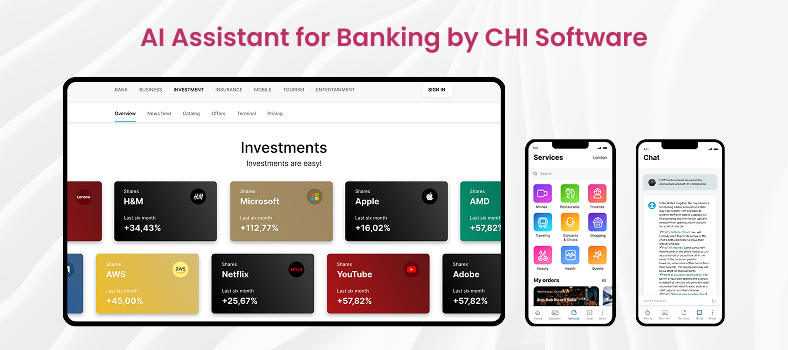Finding the right file shouldn’t feel like a treasure hunt. Yet still, many teams still waste hours digging through contracts, policies, or reports.
According to Pew Research Center, almost half of U.S. employees are already turning to AI chatbots to help out with daily tasks at work – and among those who do, 40% say the tools help them move faster, while nearly a third report noticeable improvements in work quality. For companies, document search bot development is quickly becoming a practical way to cut that wasted time.
CHI Software’s team, a chatbot development company, has seen the benefits of AI assistance in real projects. The AI banking assistant we built, for example, was trained to pull key details from complex contracts in seconds – not hours or days. Real impact like this makes AI assistants worth building.
In this article, we’ll look at how a document search chatbot works, the business value it brings, and what it takes to build one – from getting your files into the right shape, to setting up a chatbot that employees can actually use in their daily work.
Article Highlights:
- Chatbots turn hours of document search into seconds with Optical Character Recognition (OCR), Natural Language Processing (NLP), embeddings, and a Large Language Model (LLM).
- Studies show up to 20% faster task completion and 15% higher productivity with chatbots for document search.
- Strong chatbot foundations matter: clean documents, metadata, access rules, and compliance.
- Development path: start with a narrow scope, design for users, test in real workflows, then scale.
- CHI Software cases: banking contract assistant, EdTech bot cutting teacher workload by 50%, ERP assistant reducing response time by 20%.
How Does AI-Based Document Search Work?
At its core, a document search chatbot connects two worlds: how employees ask questions in everyday language and how you store information inside document-driven systems and company files. Instead of scrolling through folders or trying to guess the right keyword, users simply ask, and the chatbot delivers the most relevant section of the right document with a direct link for verification.

That’s a simple illustration of how AI-based document search works.
The process usually follows four main stages:
- Document ingestion: A manager uploads files of all formats (PDFs, Word docs, scans, spreadsheets) into secure storage. If documents are scanned images, optical character recognition (OCR) converts them into searchable text.
- Organization and indexing: After ingestion, the documents need structure. The system removes noise, applies metadata, and prepares the content for fast retrieval. In AI-based document search development, this step relies on vector databases that transform text into embeddings – mathematical “fingerprints” of meaning – so the chatbot can recognize context, instead of simply matching exact keywords.
- Query interpretation: When a user types a question, natural language processing (NLP) translates it into something the system can match against the document database.
- Response generation: The AI chatbot for document retrieval can provide a concise answer and often shows a snippet of the source, so users can instantly validate it.
Let’s break down the core technologies powering chatbots for document-based search.
Natural Language Processing
NLP can understand how people phrase questions. In AI document chatbot development, this capability allows algorithms to recognize synonyms, intent, and even vague queries. For example, “What’s our vacation policy?” and “How many days of paid time off do I get?” should trigger the same document snippet.
Optical Character Recognition
OCR converts scanned files or images into machine-readable text. This technology is crucial when businesses deal with contracts, invoices, or medical records still stored as scans. Without OCR, large parts of the document base stay functionally invisible to the chatbot.
Vector Databases and Embeddings
Traditional keyword search often fails when the wording of the query doesn’t match the document exactly. With embeddings, the system can recognize that “annual leave” and “vacation days” mean the same thing. Vector databases store these embeddings and make contextual search possible at scale.
Large Language Models (LLMs) and Retrieval-Augmented Generation (RAG)
LLM-based models like GPT interpret queries and generate natural responses, but they can “hallucinate” if they’re left unchecked. That’s why modern chatbot development often combines them with retrieval-augmented generation, which anchors the answer in verified company files. This approach enables reliable document search using LLMs – employees get context-aware responses, but always backed by actual documentation.
Together, these technologies make it possible to build a document chatbot that actually fits into everyday work. Instead of adding another tool people struggle to adopt, the chatbot becomes part of existing workflows, shortening the search process and giving employees reliable answers when they need them.
And before jumping into development, there are a few things every company should prepare.
How Your Document Search Bot Can Improve Operations
A document search chatbot shortens the gap between a question and the correct answer. Instead of digging through folders and messy file structures, employees can pinpoint the exact passage they need in seconds. Here’s where that speed translates into real operational value.

An AI chatbot for document retrieval can optimize your resources and provide easy access to all types of corporate data.
Quicker Access to Complex Information
A Harvard Business School study found that employees using AI were able to complete information-heavy tasks 20% faster, and with more comprehensive results. While the study looked at service roles, the takeaway here is broader: the same acceleration happens when staff are able to use a chatbot to pull compliance rules, HR policies, or technical procedures from large document sets.
Proven Productivity Gains Across Teams
Field research on arXiv showed that access to a document search chatbot improved task completion by 15% per hour, with the greatest lift among less experienced staff. In practice, this benefit means a document search chatbot not only helps senior employees move faster, but also levels the field for newer team members by guiding them straight to the right information.
Hours Saved at Scale
The McKinsey “Superagency” report projects that AI copilots can save employees dozens of working hours per month by simplifying knowledge retrieval and repetitive text-based tasks. This saving far outweighs the initial chatbot development cost.
In document-heavy industries such as banking, healthcare, and insurance, those hours translate into faster contract reviews, quicker regulatory checks, and more efficient onboarding.
To make these benefits real, however, companies need to prepare their data first – let’s move to the prerequisites for building your own AI assistant.
Prerequisites for Building a Document Search Chatbot
Before you can work up to document search chatbot development, solid groundwork has to be in place first. A chatbot is only as effective as the information it has access to, and the guardrails around that information. Here are the essentials every business should prepare:

Consider all these aspects if you want AI document chatbot development go smoothly and bring the desired outcomes.
1. Digitized and Searchable Documents
We’ve seen projects stall simply because files were locked inside scanned PDFs or stored in messy folders. A document search bot can’t read what it can’t access. Running OCR on old scans and bringing everything into machine-readable formats is the first step we recommend.
2. Consistent Structure and Metadata
Even the smartest tool will struggle if the documents are inconsistent. Adding metadata and clear categories helps create a foundation for a knowledge base chatbot that employees can rely on. Think of it as giving the chatbot a map and a flashlight instead of leaving it to wander in the dark.
3. Security and Access Control
One of the earliest questions we ask clients is, ‘Who should see what?’ – if you do not define the answer up front, problems are likely to appear later. When you build a chatbot for internal document search, HR, finance, and legal teams often need very different access rights. Role-based control and encryption save many headaches down the road.
4. Compliance and Data Sensitivity
If you’re in healthcare, banking, or law, regulations shape the entire setup. We’ve built bots that need to meet GDPR, HIPAA, and even internal audit requirements. Preparing for compliance early usually prevents unnecessary cost and rework later.
5. Clear Use Cases
We’ve also seen enthusiasm work to derail projects when companies try to solve everything at once. The best results come from starting small – for example, focusing only on contract analysis or HR policy questions – and expanding once the first success is visible.
This preparation stage saves both time and frustration. Without it, even the most advanced AI document chatbot development project can risk stalling in the pilot stage – a common challenge in early chatbot implementation.
How to Develop a Document Search Chatbot in 6 Steps
Once the preparation is complete, the real work on document search bot development begins. From our experience, the difference between a chatbot that feels like a toy and one that becomes part of daily work lies in the details. Here’s how we approach it, step by step:

These six steps explain in a nutshell how to develop a document chatbot.
Step 1. Define the First “Win”
We always begin by focusing on a single clear use case. In banking, this step often involves helping employees navigate contracts. For example, during our banking digital assistant project, we trained the system to extract key clauses, such as payment terms, conditions, or dates, directly from long agreements. What used to require time-consuming manual review became with our solution just a quick query to the chatbot – a visible improvement that built trust in the document search chatbot.
Step 2. Design the User Experience
If using a chatbot disrupts your employees’ workflow, they won’t continue using it. That’s why thinking about UX design from an early stage is critical. Some clients asked us to integrate their chatbot for document search into Slack or Teams, while others needed a standalone web interface with filtering and export options.

Our AI chatbot for education saved 40% of teachers’ time and cut their overall workload by half.
In the AI chatbot assistant for education that we built, the interface allowed teachers to generate test questions with just a few clicks, rather than spending hours drafting them manually. That simplicity was key to adoption – it saved 40% of teachers’ time and cut their overall workload by half.
Step 3. Choose the Technical Core
At this stage, document search bot development starts getting technical. Each project requires the right mix of tools to successfully build a chatbot that aligns with the business’ needs:
- LLMs for understanding queries (we’ve used GPT-based models for nuanced answers, and lighter models for on-premise, compliance-heavy clients).
- Vector databases for storing embeddings and enabling contextual retrieval.
- RAG pipelines to keep answers grounded in company data rather than the model’s generic knowledge.
In one of our enterprise projects, an AI-based ERP assistant analyzed past proposals and automatically generated answers to new questions. Using retrieval and generation, this document search bot reduced response time by 20%, helping sales teams meet deadlines without sacrificing quality.
Step 4. Add Business Logic
A document search chatbot needs to follow your business rules, not just return text – which leads us to setting up boundaries:
- Should employees see the entire file or just the relevant paragraph?
- Should every answer include a source citation?
- How should access vary by department?
In CHI Software’s work on a banking assistant solution, answers always pointed to the original contract snippet, ensuring transparency. In education, our AI assessment bot generated diverse test questions and also flagged them with metadata – such as subject, grade, and complexity – so that teachers could filter them easily and instantly.

This AI assistant always points to the original contract snippet to ensure transparency.
Step 5. Test in Real Conditions
No internal test environment can fully predict how employees will interact with chatbots for document search. Real-world pilots often reveal unexpected queries, abbreviations, or typos.
Step 6. Scale and Evolve
In practical reality, scaling implies much more than just expanding the dataset – it requires keeping pace with how employees actually use the chatbot and what they expect from it. Some chatbots start small (contract lookups, policy Q&A) and later grow into an enterprise-wide platform with multilingual support, analytics dashboards, and API connections into CRMs or ERPs.
We scaled an AI chatbot for document retrieval from a single workflow into a multi-feature assistant that was implemented across multiple teams. In education, our assessment bot expanded from basic test creation to personalized learning recommendations, boosting student engagement by 50%.
Here’s our practical answer to how to build a chatbot that can search documents. But there’s one more lesson we always share with clients: don’t treat the chatbot as a finished product – the most successful ones are managed like living systems that collect feedback, improve with new data, and adapt as business needs change. That ongoing attention is what turns a pilot into a trusted daily tool.
Conclusion
Building a document search chatbot can help you solve a very practical problem: the wasted hours employees spend looking for information. As the research shows, AI assistants improve speed, accuracy, and consistency of work. From our own projects, we’ve seen them cut teacher workloads in half, transform contract review into a matter of seconds, and help enterprises respond to RFPs faster.
The path to success is clear: begin by preparing your documents for a single, focused use case. Design for the way people actually work, and refine your solutions continuously. Treated as a living system, a document search bot has the potential to become part of everyday decision-making.
If you’re considering such a project for your organization, reach out via our contact form to discuss your next steps. With over 80 AI experts and experience serving both Fortune 500 companies and fast-growing startups, CHI Software can guide you from preparation to deployment with ease.
FAQs
-
Can you tailor a document search bot to my company’s workflows and terminology?

Absolutely! A document search chatbot is only effective if it reflects how your teams actually work. CHI Software’s experts train chatbots on company-specific documents, apply custom metadata, and fine-tune the model to recognize your terminology and business rules. These measures ensure the chatbot feels like a natural part of your processes, rather than a generic or superfluous tool.
-
How quickly can my company launch a document search chatbot?

The timeline depends on the state of your documents and the scope of the first use case. In our experience:
- Small pilots (e.g., HR policies, FAQs) can launch in 6-8 weeks.
- Enterprise-scale solutions with compliance, integrations, and multilingual support typically take longer but benefit from phased rollout (starting out narrow and expanding over time).
-
What are the common pitfalls when companies try to build a document search bot on their own?

Here are the issues we notice most often:
1. Starting too broad instead of focusing on one workflow.
2. Using unstructured, inconsistent, or scanned files without proper preprocessing.
3. Choosing an LLM first but neglecting the retrieval layer.
4. Skipping role-based access and security, leading to trust issues.
5. Underestimating the importance of user experience (like where the chatbot lives, how it responds).
6. Failing to run real-world pilots and gather employee feedback early.
-
What makes CHI Software a reliable partner for building a document search chatbot?

CHI Software’s team has spent years working with AI in real business settings. What matters most to us is how chatbots make daily work easier and more reliable. Here are a few reasons companies trust us with document search bot development:
- Proven experience: over 20 AI assistants delivered across banking, EdTech, healthtech, and enterprise operations.
- Expert team: more than 80 AI specialists with deep capabilities in NLP, OCR, data engineering, and compliance.
- Real business impact: case studies include a banking assistant for contract clauses, an EdTech bot that cut teacher workload by 50%, and an enterprise RFP assistant that reduced response times by 20%.
- Trusted by industry leaders: we work with both Fortune 500 companies and innovative startups.
- Security-first approach: GDPR- and HIPAA-compliant solutions for strictly regulated industries.
About the author
Olha boasts a decade-long journey in NLP, currently serving as a researcher at Jena University and a Consulting ML/NLP Engineer at CHI Software. Her expertise extends to various realms of NLP, including text summarization, named entity recognition, and keyword extraction. Olha's Ph.D. thesis explored knowledge representations and information retrieval in librarian systems.
Yana oversees relationships between departments and defines strategies to achieve company goals. She focuses on project planning, coordinating the IT project lifecycle, and leading the development process. In their role, she ensures accurate risk assessment and management, with business analysis playing a key part in proposals and contract negotiations.
Rate this article
45 ratings, average: 4.89 out of 5















“The hardest part isn’t choosing the use case – it’s saying no to everything else in the beginning. Clients often want a bot that answers every question. In practice, starting narrow builds trust much faster.”